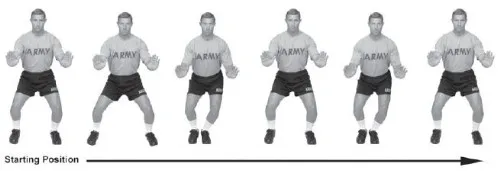The Lateral is the second exercise in Military Movement Drill One. This exercise is specifically designed to develop the ability to move laterally.
- It serves as a preparatory exercise for more rigorous training, testing, and combat activities.
Table of Contents
show
Military Movement Drill 1, Exercise 2: Laterals

Purpose:
- This exercise aims to increase agility, coordination, and balance by teaching soldiers how to move effectively and efficiently in a lateral direction.
Starting Position:
- Straddle stance, slightly crouched with the back straight.
- Arms are at the side with elbows bent at 90 degrees, and palms facing forward.
- The soldier should stand perpendicular to the direction of the intended movement.
Movement:
- From this starting position, you’ll step out with the lead leg.
- Subsequently, bring the trail leg up, moving it toward the lead leg.
- Throughout this exercise, the soldier maintains their facing direction.
- This means that for the initial 25 meters, the soldier moves to the left.
- For the following 25 meters, the movement shifts to the right.
Progression:
- As proficiency in the exercise develops, the soldier can gradually increase their speed.
Video: Illustration showcasing the proper movement and form of the exercise
Check Points:
- Feet Movement: Ensure that feet are lifted during each step, avoiding any dragging on the ground.
- Posture: Maintain a slight crouch while keeping the back straight. This position enables quick lateral movement while ensuring safety and stability.
- Footwork: Be cautious to prevent the feet or ankles from hitting each other with each step. Such missteps can lead to tripping or injury.
- Direction: Rank leaders will ensure they face their rank throughout the entire exercise, providing an orientation point for soldiers.
Muscles Worked:
- Glutes: These muscles are responsible for the sideways movement and stability of the hip joint.
- Quadriceps and Hamstrings: Engaged to help lift the legs and stabilize the knees.
- Abductors and Adductors: These inner and outer thigh muscles are used intensively in lateral movements.
- Core Muscles: The rectus abdominis, obliques, and lower back muscles provide stability and posture during the exercise.
Benefits:
- Improved Agility: Lateral movements are essential in various combat and field scenarios where quick side-to-side movements can be crucial.
- Enhanced Coordination: Regular practice can enhance muscle memory and coordination, leading to more fluid and responsive lateral movements.
- Strengthened Lower Body Muscles: This drill targets and strengthens several lower body muscles, leading to better overall leg strength.
- Increased Balance: Lateral movements require a good sense of balance to prevent tripping or falling.
Training Tips:
- Start Slowly: If new to the exercise, it’s recommended to start at a slower pace to get accustomed to the movement.
- Stay Low: The crouched position is essential for effective lateral movement and minimizes the risk of injuries.
- Engage the Core: Activating the core muscles will provide better balance and support during the movement.
- Consistent Practice: Like any other exercise, consistent practice will lead to improved performance and mastery of the movement.
Precaution:
- While there aren’t any specific precautions mentioned for this exercise, it’s always essential to ensure proper warm-up before beginning and to be aware of the surroundings to avoid any obstacles or hazards.
In essence, this lateral movement is pivotal for enhancing agility, especially in changing terrains and situations that soldiers might face in the field.
Latest posts by George N. (see all)
- Empowering Transactions: Navigating Firearms Sales with Proper Documentation - April 8, 2024
- Army PRT – Preparation and Recovery 2024 - March 18, 2024
- Active and Reserve Components 2024 - March 6, 2024
